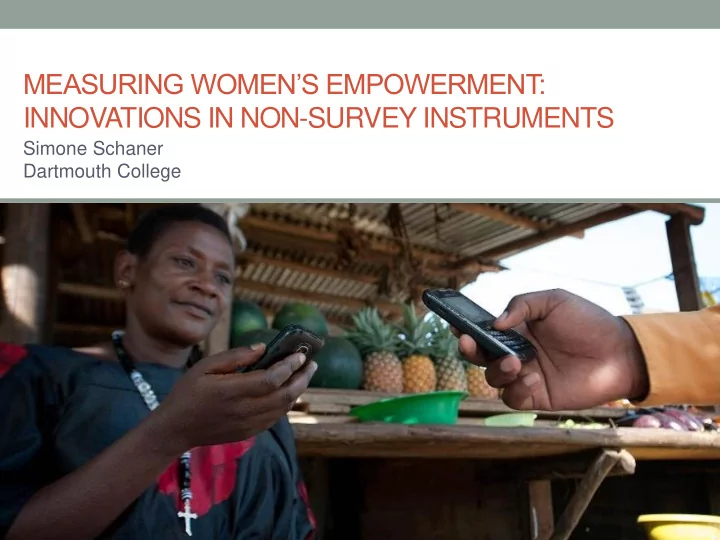

MEASURING WOMEN’S EMPOWERMENT: INNOVATIONS IN NON-SURVEY INSTRUMENTS Simone Schaner Dartmouth College
From the Pre-Event Survey What are the two most important areas to address in improving measurement? Indicators and vocabulary 3 Interdisciplinary collaboration 2 Standardization vs. customization 3 Validation exercises 7 Stated vs. revealed preferences 5 Non-survey instruments 5 Policy influence/relevance 1 0 1 2 3 4 5 6 7 8
The Promise of Non-Survey Instruments • Many issues with self-reported survey questions (e.g. social desirability bias, subjectivity, difficult to communicate complex concepts) • Growing popularity of non-survey instruments like: • Implicit association tests (e.g. Chattopadhyay et al. 2009) • Biometric measurements (anemia, BMI/MUAC, cortisol, etc. – Haushofer and Shapiro 2016, Field et al. in progress) • Willingness to pay (e.g. to control transfers - Almas et al. 2015) • “Lab -in-the- field” games (e.g. Castilla 2016, Schaner forthcoming) • Vignettes (e.g. Massett, 2015) • Structured activities (e.g. Casey et al. 2012) • (Potential) advantages of non-survey instruments include: • Directly observe outcome (or process) of interest • Measure environment/context in which women are taking decisions/interacting
Proposed Framework: What Makes a Good Non-Survey Instrument? Start with a model/definition of empowerment 1. Does the model make clear , unambiguous predictions about how 2. the NSI should move with empowerment? • Be precise about assumptions! Pretest, pretest, pretest!!!! 3. • Do study staff and subjects understand the protocol? • Do subjects make choices that are consistent with theory/model? Draw on past validation and conduct your own 4. • Do measures vary with other proxies of empowerment? • Do measures move with plausibly exogenous variation in empowerment?
Example: “Bargaining Game” (Schaner, forthcoming, Field et al., in progress) Model/definition of empowerment • Assume collective model of decision-making (when deciding what the consume, household maximizes a weighted average of male/female preferences) • Empowerment = relative weight on female preferences • Challenge: we cannot directly observe preferences, the bargaining weight! • Solution: lab-in-the-field style game where preferences, bargaining can be directly observed • Husband and wife make choices both privately and together, incentivized payment is private
Example: “Bargaining Game” (Schaner, forthcoming, Field et al., in progress) Are predictions clear? • Yes, BUT….. • Must assume log utility over cash payouts (narrow bracketing) Pretesting • Numerous iterations to ensure respondents understand process • Goods vs. cash • Need to incorporate altruism • Add questions measuring behavior during bargaining
Results From Kenya, India
Validation Validation with (hypothesized) exogenous changes in bargaining power pending
Discussion Questions 1. Which models of empowerment are most amenable to non-survey instruments? 2. Is there a trade-off between using non-survey instruments to identify well-defined theoretical constructs versus capturing behaviors that have practical meaning? What is the right balance? 3. What types of behaviors should we expect to move in the short versus long run? 4. What non-survey instruments do members of the group find most promising?
Recommend
More recommend